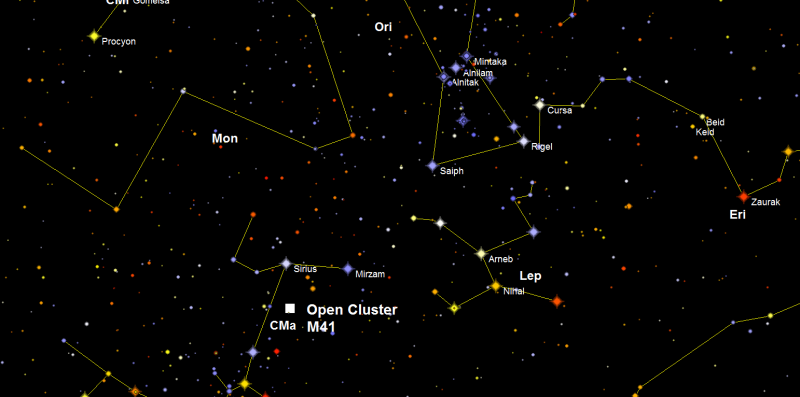2016 January 15
Big dog great cluster
Dominating the southern night sky at this time of the year, Orion is not only a majestic constellation in its own right but also a great signpost to other constellations. In particular the 3 belt stars point upwards to Taurus the Bull and downwards to Canis Major the Greater Dog. Canis Major is of course home to the brightest star in the night sky, the magnitude -1.5 Sirius which at a distance of 8.7 light years is also one of the closest stars to us. And Sirius itself is a signpost to one of the gems of the winter sky – the open star cluster Messier 41. M41 is a naked eye object (just) from a good dark site and like so many naked eye deep sky objects its observational and discovery history is messy.
It’s impossible to determine who the first person to discover M41 was, but it is quite likely that several thousand years ago Neanderthal man sitting outside his cave was puzzling over the nature of this fuzzy patch. It is thought to have been observed by Aristotle in the 4th century BC but the first true observation seems to have been by the obscure Italian astronomer, friend of Galileo and early deep sky cataloguer, Giovanni Hodierna in the mid-15th century using a small refractor. Flamsteed also observed it in February 1702 and Messier, unaware of these earlier observations, recorded the cluster in January 1765 and it became number 41 in his list of comet lookalikes
Possibly one of the easiest deep sky objects to locate (see chart below), M41 lies 4 degrees almost due south of Sirius so is easily swept up in binoculars. In fact small binoculars, with their typical 5 degree or so field of view, will allow both the cluster and Sirius to be seen in the same field (although larger binoculars will clearly give a more impressive view). The cluster, which consists largely of mag 7 to mag 10 stars, many arranged in curved chains, has a relatively empty centre which contains a prominent magnitude 6.9 red giant star. With a diameter approaching half a degree on the sky, M41 lies approximately 2,300 light years distant has a true diameter of around 24 light years and is estimated to have an age of 190 million years.

https://britastro.org/wp-content/uploads/2022/02/M41-Gavin.jpg
https://britastro.org/wp-content/uploads/2022/02/M41-Gavin.jpg
https://britastro.org/wp-content/uploads/2022/02/M41-Gavin.jpg
https://britastro.org/wp-content/uploads/2022/02/M41-Gavin.jpg
https://britastro.org/wp-content/uploads/2022/02/M41-Gavin.jpg
https://britastro.org/wp-content/uploads/2022/02/M41-Gavin.jpg
https://britastro.org/wp-content/uploads/2022/02/M41-Gavin.jpg
https://britastro.org/wp-content/uploads/2022/02/M41-Gavin.jpg
https://britastro.org/wp-content/uploads/2022/02/M41-Gavin.jpg
https://britastro.org/wp-content/uploads/2022/02/M41-Gavin.jpg
https://britastro.org/wp-content/uploads/2022/02/M41-Gavin.jpg
https://britastro.org/wp-content/uploads/2022/02/M41-Gavin.jpg
https://britastro.org/wp-content/uploads/2022/02/M41-Gavin.jpg
https://britastro.org/wp-content/uploads/2022/02/M41-Gavin.jpg
https://britastro.org/wp-content/uploads/2022/02/M41-Gavin.jpg
https://britastro.org/wp-content/uploads/2022/02/M41-Gavin.jpg
https://britastro.org/wp-content/uploads/2022/02/M41-Gavin.jpg
https://britastro.org/wp-content/uploads/2022/02/M41-Gavin.jpg
https://britastro.org/wp-content/uploads/2022/02/M41-Gavin.jpg
https://britastro.org/wp-content/uploads/2022/02/M41-Gavin.jpg
https://britastro.org/wp-content/uploads/2022/02/M41-Gavin.jpg
https://britastro.org/wp-content/uploads/2022/02/M41-Gavin.jpg
https://britastro.org/wp-content/uploads/2022/02/M41-Gavin.jpg
https://britastro.org/wp-content/uploads/2022/03/M41-Gavin.jpg
https://britastro.org/wp-content/uploads/2022/03/M41-Gavin.jpg
https://britastro.org/wp-content/uploads/2022/03/M41-Gavin.jpg
https://britastro.org/wp-content/uploads/2022/03/M41-Gavin.jpg
https://britastro.org/wp-content/uploads/2022/02/M41-Gavin.jpg
https://britastro.org/wp-content/uploads/2022/02/M41-Gavin.jpg
https://britastro.org/wp-content/uploads/2022/02/M41-Gavin.jpg
https://britastro.org/wp-content/uploads/2022/02/M41-Gavin.jpg
https://britastro.org/wp-content/uploads/2022/02/M41-Gavin.jpg
https://britastro.org/wp-content/uploads/2022/02/M41-Gavin.jpg
https://britastro.org/wp-content/uploads/2022/02/M41-Gavin.jpg
https://britastro.org/wp-content/uploads/2022/02/M41-Gavin.jpg
https://britastro.org/wp-content/uploads/2022/02/M41-Gavin.jpg
https://britastro.org/wp-content/uploads/2022/02/M41-Gavin.jpg
https://britastro.org/wp-content/uploads/2022/02/M41-Gavin.jpg
https://britastro.org/wp-content/uploads/2022/02/M41-Gavin.jpg
https://britastro.org/wp-content/uploads/2022/02/M41-Gavin.jpg
https://britastro.org/wp-content/uploads/2022/02/M41-Gavin.jpg
https://britastro.org/wp-content/uploads/2022/02/M41-Gavin.jpg
https://britastro.org/wp-content/uploads/2022/02/M41-Gavin.jpg
https://britastro.org/wp-content/uploads/2022/01/M41-Gavin.jpg
https://britastro.org/wp-content/uploads/2022/02/M41-Gavin.jpg
https://britastro.org/wp-content/uploads/2022/02/M41-Gavin.jpg
https://britastro.org/wp-content/uploads/2022/02/M41-Gavin.jpg
https://britastro.org/wp-content/uploads/2022/01/M41-Gavin.jpg
https://britastro.org/wp-content/uploads/2022/01/M41-Gavin.jpg
https://britastro.org/wp-content/uploads/2022/01/M41-Gavin.jpg
https://britastro.org/wp-content/uploads/2022/01/M41-Gavin.jpg
https://britastro.org/wp-content/uploads/2022/01/M41-Gavin.jpg
https://britastro.org/wp-content/uploads/2022/01/M41-Gavin.jpg
https://britastro.org/wp-content/uploads/2022/01/M41-Gavin.jpg
https://britastro.org/wp-content/uploads/2022/02/M41-Gavin.jpg
https://britastro.org/wp-content/uploads/2022/01/M41-Gavin.jpg
https://britastro.org/wp-content/uploads/2022/01/M41-Gavin.jpg
https://britastro.org/wp-content/uploads/2021/11/M41-Gavin.jpg
https://britastro.org/wp-content/uploads/2021/11/M41-Gavin.jpg
https://britastro.org/wp-content/uploads/2021/11/M41-Gavin.jpg
https://britastro.org/wp-content/uploads/2021/11/M41-Gavin.jpg
https://britastro.org/wp-content/uploads/2021/07/M41-Gavin.jpg
https://britastro.org/wp-content/uploads/2021/07/M41-Gavin.jpg
https://britastro.org/wp-content/uploads/2016/01/M41-Gavin.jpg
https://britastro.org/wp-content/uploads/2016/01/Position-of-M41_1.png
https://britastro.org/wp-content/uploads/2022/02/M41-Gavin.jpg
https://britastro.org/wp-content/uploads/2022/02/M41-Gavin.jpg
https://britastro.org/wp-content/uploads/2022/02/M41-Gavin.jpg
https://britastro.org/wp-content/uploads/2022/02/M41-Gavin.jpg
https://britastro.org/wp-content/uploads/2022/02/M41-Gavin.jpg
https://britastro.org/wp-content/uploads/2022/02/M41-Gavin.jpg
https://britastro.org/wp-content/uploads/2022/02/M41-Gavin.jpg
https://britastro.org/wp-content/uploads/2022/02/M41-Gavin.jpg
https://britastro.org/wp-content/uploads/2022/02/M41-Gavin.jpg
https://britastro.org/wp-content/uploads/2022/02/M41-Gavin.jpg
https://britastro.org/wp-content/uploads/2022/02/M41-Gavin.jpg
https://britastro.org/wp-content/uploads/2016/01/Position-of-M41_1.png
https://britastro.org/wp-content/uploads/2022/02/M41-Gavin.jpg
https://britastro.org/wp-content/uploads/2022/02/M41-Gavin.jpg
https://britastro.org/wp-content/uploads/2022/02/M41-Gavin.jpg
https://britastro.org/wp-content/uploads/2022/02/M41-Gavin.jpg
https://britastro.org/wp-content/uploads/2022/02/M41-Gavin.jpg
https://britastro.org/wp-content/uploads/2022/02/M41-Gavin.jpg
https://britastro.org/wp-content/uploads/2022/02/M41-Gavin.jpg
https://britastro.org/wp-content/uploads/2022/02/M41-Gavin.jpg
https://britastro.org/wp-content/uploads/2022/02/M41-Gavin.jpg
| The British Astronomical Association supports amateur astronomers around the UK and the rest of the world. Find out more about the BAA or join us. |
